Optimize Your Health Prior to Surgery
A joint replacement is a successful procedure in highly motivated patients with the appropriate indications for surgery. Prior to surgery, it is critical that you optimize your overall health to ensure the best possible outcome. Following these steps will help you set yourself up for a successful procedure and recovery.
- Balance your diet and supplement with a daily multivitamin
- Attempt to obtain a healthy BMI ratio prior to surgery. Patients with a BMI > 40 have a significantly higher infection risk.
- Bloodwork at your preoperative visit will be evaluated and if needed, referrals for optimization will be made
- If you are diabetic, strict perioperative blood sugar control is imperative. If your blood sugars are elevated in this time period, you have a significantly higher risk of infection. We will reschedule all patients with a HgA1C > 8 and refer to their primary care physician for improved glycemic control
- Discuss any medications you are taking to see which ones you should stop prior to surgery
- If you are taking aspirin, anti-inflammatory medication or any drug that increases the risk of bleeding, you will need to stop taking them one week before surgery to minimize perioperative blood loss.
- Quit smoking. Smoking inhibits wound healing and significantly increases the risk of infection after joint replacements.
- Report any recent infections. Surgery can not be performed until all infections have cleared.
- Set up an appointment with a physical therapist prior to surgery. This will allow a smooth transition into the recovery phase.
- Work on knee and hip replacement prehabilitation exercises (attached below) prior to surgery.
Preparing Your Home For Recovery
Navigating your home is key in the post operative period. Taking a few steps prior to your surgery can go a long way. The following information will help you and your family plan for your transition from the hospital to home.
Most patients return home immediately following surgery:
- Please be sure to arrange for someone to drive you home.
- During the first several days or weeks after you return home, you may need someone to assist you with personal care and meal preparation. Please make plans to have family, friends or private caretakers available to help.
- Preparing ahead of time before your surgery can reduce the amount of help needed. This may include:
- Having your house cleaned
- Placing clean linens on your bed
- Preparing several days worth of frozen meals
- Keeping your phone and other frequently used items close at home
- Arranging for someone to care for your pets
- Remove all loose carpets and tape down electrical cords to avoid falls
- Your therapists will help you determine your need for any assistive equipment. Therefore, it is usually best to wait until your hospital stay to purchase equipment such as:
- Rolling walker, crutches or cane
- Bedside commode
- The social worker will arrange for the equipment to be delivered to your room prior to your discharge. If you already have a walking device, please place your name on it and bring it with you to the hospital. Your therapists can inspect them for safety and appropriateness. Often, a walking device may be necessary for your journey home.
- Based on your progress you will be prescribed one of the following options for therapy after your hospital stay.
- Home Exercise Program: Independently continue the exercises as demonstrated by the hospital therapist.
- Outpatient Physical Therapy: You will be provided with a prescription for outpatient physical therapy. There are multiple outpatient physical therapy clinics in the community. Please choose one, call the clinic to make an appointment, and they will verify insurance coverage.
- Home Health Physical Therapy: Social services will assist in arranging home health therapy. Depending on your progress, the length of time for home health is usually 2-3 weeks. If you need continued therapy, outpatient therapy will be prescribed.
Basic Prehabilitation and Rehabilitation Exercises for Total Hip & Knee Replacement:
- Ankle Pumps: Ankle Pumps help prevent the development of blood clots and leg swelling. While lying on your back or sitting in a chair, move both feet up and down. You will do ankle pumps before surgery, when you are awake in the recovery room, during your hospital stay, and at home.
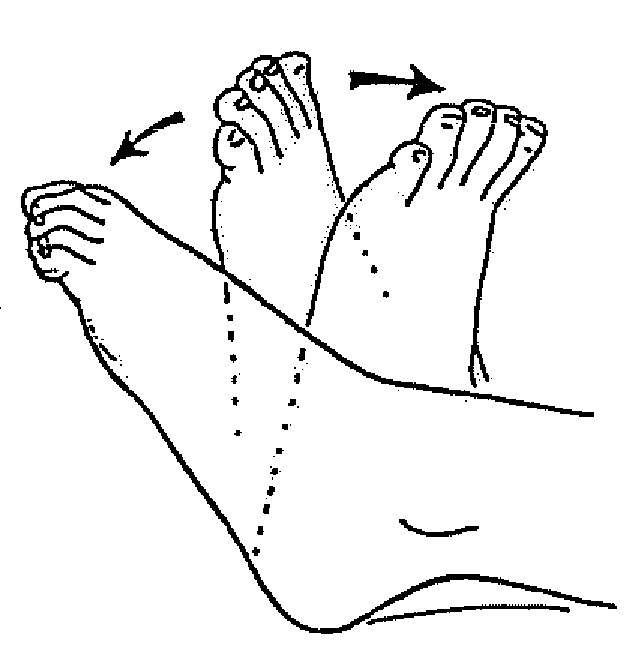 Your goal: 200 ankle pumps per day, doing 20-50 at a time, four times a day, before and after surgery. Remember this exercise is for both feet.
Your goal: 200 ankle pumps per day, doing 20-50 at a time, four times a day, before and after surgery. Remember this exercise is for both feet. - Gluteal Sets or Pelvic Lifts: Gluteal Sets help you walk, climb stairs, and reduce back strain. While lying on your back with your knees bent and your feet pulled back toward your buttocks, lift your pelvis off the bed as high as you can; then slowly lower your pelvis back to the bed and repeat this exercise.
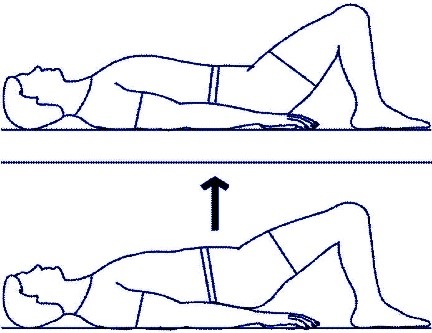 Your goal: 200 of these exercises a day, doing 20-50 at a time, four times a day, before and after surgery.
Your goal: 200 of these exercises a day, doing 20-50 at a time, four times a day, before and after surgery. - Foot Slides: Foot Slides are helpful in regaining knee and hip flexion after surgery. While sitting in a chair, put a cardboard folder on the floor under the foot of your operated leg; then slide your foot and the folder back and forth, bending your knee as much as you can. You can also do this exercise on a smooth slick floor without using the folder by either putting a towel under your foot or wearing a sock.
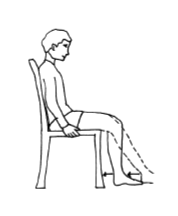 Your goal: 200 of these exercises a day, doing 20-50 at a time, four times a day, before and after surgery.
Your goal: 200 of these exercises a day, doing 20-50 at a time, four times a day, before and after surgery. - Quad Sets and Knee Presses: Quad Sets and Knee Presses help you gain leg control and improve circulation. While lying on your back in bed tighten your thigh muscles by pressing your knee downward onto the bed. If sitting in a chair with your leg out straight resting on the floor or on a stool, tighten your thigh muscles by pressing your knee downward toward the floor. Try to straighten your knee as much as possible and hold for about three seconds; then relax and repeat this exercise.
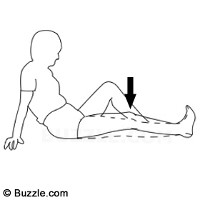 Your goal: 200 of these exercises a day, doing 20-50 at a time, four times a day, before and after surgery.
Your goal: 200 of these exercises a day, doing 20-50 at a time, four times a day, before and after surgery.Note: Do not do these exercises if you have back problems or if these exercises cause back pain
- Sitting Abduction/Adduction: The Sitting Abduction/Adduction exercise improves hip motion, muscle tone, and help eliminate limping. While sitting with your feet together, spread your knees apart as far as you can; then bring knees back together again.
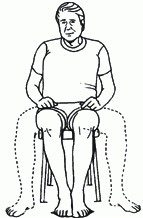 Your goal: 200 of these exercises a day, doing 20-50 at a time, four times a day, before and after surgery.
Your goal: 200 of these exercises a day, doing 20-50 at a time, four times a day, before and after surgery. - Standing Hip Abduction: Standing Hip Abduction exercises help prevent limping by increasing your muscle strength. You can stand with your back against a closed door or a table and hold onto the doorknob or table edge while you do this exercise. Put all of your weight on your non-involved side. Then lift your involved or operative leg away from your other leg in a scissor-like fashion as far as you can…then slowly lower your leg, bring it back in place, and repeat this exercise. If you need more support, you can stand in a corner for support, with your non-involved side toward the corner and your back against the wall while you do this exercise.
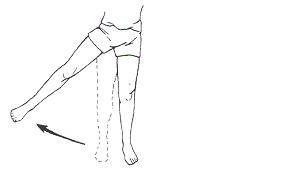 Your goal: 200 of these exercises a day, doing 20-50 at a time, four times a day, before and after surgery.
Your goal: 200 of these exercises a day, doing 20-50 at a time, four times a day, before and after surgery. - Side-Lying Hip Abduction: Side-Lying Hip Abduction exercises help minimize limping and increase your leg stability while walking. Start by lying on your non-operated side…keep your shoulder, knee, and ankle in a straight line. You might be more stable by bending the knee of your other leg. Now, raise your affected leg 10-12 inches away from your other leg…be sure to keep your knee straight…and then slowly lower your leg, and repeat this exercise. DO NOT DO THESE AFTER YOUR SURGERY FOR AT LEAST TWO WEEKS.
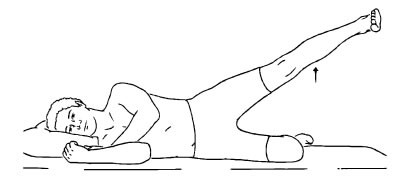 Your goal: 200 of these exercises a day, doing 20-50 at a time, four times a day, before and after surgery.
Your goal: 200 of these exercises a day, doing 20-50 at a time, four times a day, before and after surgery. - Standing Hip Flexion: Standing Hip Flexion exercises improve hip and knee motion and muscle tone. As with exercise #7 above, you can stand with your back against a closed door or a table and hold onto the doorknob or table edge while you do this exercise. Put all of your weight on your non-involved side. Then lift your involved or operative leg, bending your hip and knee as much as you can comfortably…then slowly lower you leg, bring it back in place, and repeat this exercise. If you need more support, you can stand in a corner for support, with you non-involved side toward the corner and your back against the wall while you do this exercise.
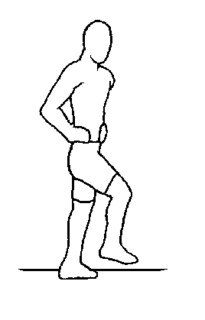 Your goal: 200 of these exercises a day, doing 20-50 at a time, four times a day, before and after surgery.
Your goal: 200 of these exercises a day, doing 20-50 at a time, four times a day, before and after surgery.
- Basic Prehabilitation and Rehabilitation Exercises for Total Hip Replacement
- Basic Prehabilitation and Rehabilitation Exercises for Total Knee Replacement
You will need the Adobe Reader to view and print these documents. 










